
Chain saw
Safety tips for felling (cutting down a tree):
These tips apply specifically to felling trees that have a diameter less than the length of the chain saw blade, although some will apply generally to felling larger trees.
- Notify the proper authorities before felling near buildings, power lines, roads or railways.
- Size up tree for diameter and direction of lean before cutting.
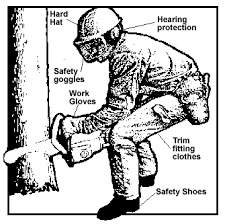
- Choose direction of fall according to the lean and shape of tree (e.g., more heavily branched on one side) and wind direction. Other factors that can affect the direction of the fall include the health of the tree (any signs of decay?), contact or entanglement of branches with other trees, slope of the land, and snow load.
- Check the condition of the tree to see if there are any branches that might fall on you while you are sawing.
- Make sure tree has a clear area to fall into.
- Check the fuel tank to make sure you have enough fuel to complete the job. Running out of fuel when making a cut can be hazardous.
- Clear work area of brush and debris before cutting down tree and remove any lower limbs that may interfere with your work.
- Do not overreach or cut above shoulder level.
- Clear two escape paths on the side opposite from the intended direction of fall and at about a 45° angle opposite the line of fall.
- Ensure that equipment and tools are a safe distance from the tree and are not placed in the way of your escape routes.
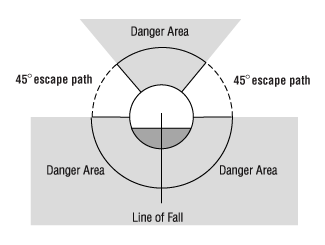
- Warn persons in area that a tree is falling (and make sure they heard the warning over the noise of the chain saw).
- Ensure that co-workers or by-standers are at least 2 tree lengths away – that is the equivalent of the height of the tree that you are felling plus the height of the tree a co-worker may be cutting down.
- If you are felling trees on sloping terrain, others workers should not be working downhill from you so that they are not exposed to sliding or rolling material.
- Move at least 7.5 m (25 feet) away when the tree starts to fall. Turn the chain saw off, and lay it in a safe place.
- Never take your eyes off a falling tree. Wait 30 seconds to allow debris to settle once the tree is on the ground.
Control the direction of the fall:
- If the tree has large buttress roots, remove pieces by first cutting vertically downward and then cutting horizontally. This will make the tree trunk more “cylindrical” and make it easier to select the direction of fall.
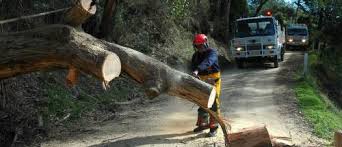
- Prepare a felling notch (also called a directional or front notch) that is perpendicular to the direction of fall.
- First, cut downward at about a 45° angle so that the bottom of the cut is in about 1/5 to 1/4 of the tree trunk diameter.
- Next, make an undercut that meets the diagonal cut exactly and remove the piece. Ensure that the felling notch is facing the intended direction of fall.
- Make a back cut or felling cut on the opposite side of the tree that is about 2.5 to 5 cm (1 to 2 in.) above the horizontal undercut. Stop just short of the undercut, leaving about 1/10 of the diameter uncut to make a hinge that will help control direction of fall.
- Use ropes or wedges to guide fall in direction other than natural lean. Wedges should be made of wood or plastic (not metal) to prevent kickback or damage to the chain in case of accidental contact.
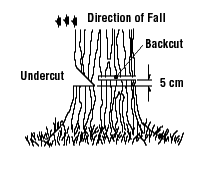
Some tips for bucking (cross cutting a log into shorter lengths):
- Clear the work area.
- Plan the cut. Determine which way the piece will fall or roll after it is cut.
- Saw the log from the uphill side of a slope.
- If possible, prop up the end to be cut off using another log.
- Cut the compression side or zone first and the tension or “stretched” side last to prevent pinching of the blade.
- Keep feet away from trunk while bucking.
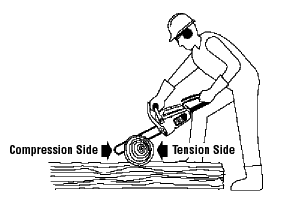
Safety tips for handling, transportation and storing:
- Handle chain saws safely to prevent injury to yourself or others.
- Shut off the chain saw motor before setting it down or carrying it for more than a very short distance. It is extremely dangerous to carry a chain saw when the engine is running.
- Let the chain saw cool before transporting.
- Use a scabbard or bar guard to cover the chain when carrying or transporting a chain saw.
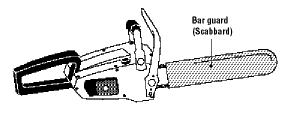
- Carry the chain saw with the bar pointed behind you. Ensure the scabbard is on and the muffler is away from the body.

- Use a carrying case to prevent damage to the saw during transit and storage. The case also provides convenient storage for the owners manual and tools.
- Secure the chain saw and carrying case during transportation to prevent them from moving.
- Drain all fuel into an approved safety container before storing the chain saw for long periods including starting the motor to empty fuel from the carburetor.
- Store your chain saw in a cool, dry place.
- Do not carry a chain saw on your shoulder unless the chain is properly guarded or removed.
- Do not transport a chain saw in the passenger compartment of a vehicle.
What is “kickback”?
Kickback is the term to describe the unexpected upward motion of the guide bar. Kickback occurs when the end portion of the nose of the bar (the kickback zone) strikes an object and the chain momentarily snags, or is pinched.
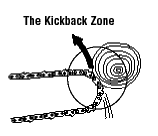
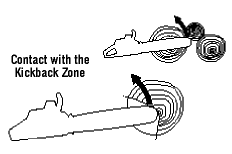
The most common and probably most violent kickback occurs when contact is made, either accidentally or intentionally, in this “kickback zone.” In some cases the blade tip may move upward and back toward the operator who could suffer a very serious or fatal injury.
I reduce the risk of kickback:
DO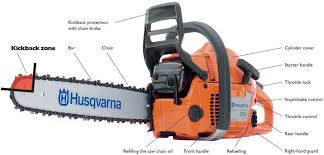
- Select a chain saw that is equipped with kickback-reducing devices (e.g., chain brake, low kickback saw chain, reduced kickback saw chain) that are designed for the chain saw that you are using and meet standards like the CSA Standard Z62.3-2004: Chain Saw Kickback, or ANSI Standard B175.1-2000: Safety Requirements for Gasoline Powered Chain Saws. These devices will reduce but will not prevent kickback.
- Watch the guide bar nose. Do not let it touch logs, branches, or the ground when saw is running.
- Cut only one piece at a time.
- Run the saw at full power when cutting.
- Keep the chain sharpened to specifications (e.g. correct depth and angle).
- Match chain and bar for exact pitch and gauge.
- Set depth gauges to manufacturer’s settings.
- Maintain correct chain tension
- Hold the saw securely with both hands. Have one hand on the handle bar and the other on the grip or trigger.
- Ensure that you have firm footing before starting to saw.
- Stand to side of the cutting path of the chain saw.
- Position yourself so that you are not near the cutting attachment when the chain saw is running.
- Know where the bar tip is at all times.
- Make sure the chain brake functions and adequately stops the chain. The stopping power of a chain brake can be greatly reduced by wear, or by oil, dirt or sawdust in the brake parts.
- Install a safety tip that covers the nose of the guide bar on the saw to prevent contact with the kickback zone. The tip must be removed for making bore cuts (pocket cuts) or for cutting wood thicker than the length of the guide bar.
- Wear any required personal protective equipment.
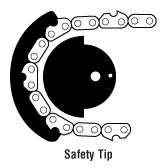
DO NOT
- Do not stand directly behind the saw.
Examples of recommended personal protective equipment:
Use proper safety clothing and personal protective equipment (PPE), that are appropriate for the tasks being performed, to reduce the risk of injury. Clothing should be well-fitting to prevent any entanglement with the chain saw. The following personal protective equipment and clothing are recommended when operating a chain saw.
The standards that are referenced below are the most recent editions. You should consult legislation or the local occupational health and safety agency in your jurisdiction to confirm which version is used or is referenced in legislation that applies to your workplaces.
Eye Protection PPE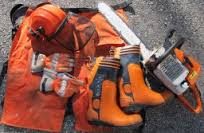
Safety glasses with side shields, safety goggles, and face shields approved by standards like CAN/CSA Standard Z94.3-07: Eye and Face Protectors, or ANSI Standard Z87.1-2010: Occupational and Educational Personal Eye and Face Protection Devices.
- A face shield attached to the hard hat without safety glasses does not provide the adequate eye protection.
Gloves & Mitts
Leather gloves with ballistic nylon reinforcement on the back.
- They offer a good grip on the saw and absorbs some vibration that provides some protection for the hands.
- Leather gloves can also prevent cuts when sharpening the saw.
Foot Protection PPE
Heavy, well-fitted, safety work boots approved by standards like CAN/CSA Standard Z195-09: Protective Footwear, or ANSI Standard Z41-1999: Personal Protection – Protective Footwear, or ASTM F2412-2005: Standard Test Methods for Foot Protection, and ASTM F2413-2005: Standard Specifications for Performance Requirements for Protective Footwear.
- In addition to the regular requirements for safety boots, chain saw operators should wear boots made from cut-resistant materials that offer protection from contact with running chain saws.
- Boots made of ballistic nylon offer the best cut protection.
- Rubber soles for wet weather and snow, and hobnail boots, grip soles or cork soles for rough terrain.

Head Protection PPE
Hard hat, highly visible in colour, approved by standards like CSA Standard Z94.1-05: Industrial Protective Headwear – Performance, Selection, Care and Use, or ANSI Standard Z89.1-2009: Industrial Head Protection.
Hearing Protection PPE
Hearing protection devices, approved by standards like CSA Standard Z94.2-02 (Reaffirmed 2007): Hearing Protection Devices – Performance, Selection, Care and Use. (Chain saws create high noise levels of up to 95 to 115 dBA.)
Leg Protection Clothing
- Trousers or chaps with sewn-in ballistic nylon pads. Trousers (pants) that protect to the belt line offer more protection than those that stop at the upper thigh.
- Close fitting clothing without cuffs, made of close-woven fabrics.
- The ASTM International has published “Standard Specification for Leg Protection for Chain Saw Users” (ASTM F1897-08).
Safety tips to know when starting the saw:
DO
- Use only chain saws that have been manufactured and maintained according to standards like the CSA Standard Z62.1-03 (R2008) “Chain Saws”and that are equipped with a safety chain and chain brake. Check legislation in your jurisdiction for other requirements.
- Know how to use the controls before starting a chain saw.
- Remove the chain guard (scabbard) and inspect the saw and machine for damaged, loose, missing parts, or other signs of wear, or leaks around the engine before starting. See OSH Answers document Chain Saws – Maintenance and Service.
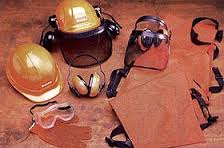
- Ensure that the guide bar is tight and chain fits snugly without binding; adjust the chain tension, if required.
- Inspect the saw chain to ensure it is properly lubricated and is sharp. Sharpen and lubricate, as needed.
- Check the air filter and clean when needed.
- Check the muffler spark arrestor screen, if present. Spark arrestor screens help reduce the risk of fire, especially in dry forest conditions.
- Inspect the chain catcher – it helps reduce the risk of injury when a chain breaks or comes off the guide bar.
- Ensure that chain is clear of obstructions before starting.
- Engage the chain brake before starting the chain saw.
- Ensure that you have secure footing and that your stance is well balanced.
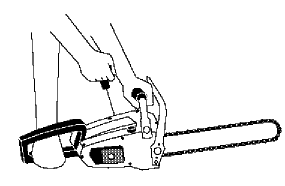
- Hold the saw firmly on the ground using your foot, or by holding the powerhead down with one hand. Point the chain away from your body and nearby obstructions. Use a quick, sharp motion on the starter cord.
- Warm up the saw prior to cutting. The saw should idle without the chain turning. If the chain continues to turn after the throttle switch is released, stop the saw. Then adjust the idle as shown in the owner’s manual.
- Check that the throttle trigger, throttle trigger interlock, master control lever, etc. are operating properly.
DO NOT
- Do not use a saw if it has damaged, improperly adjusted, or has loose or missing parts.
- Do not “drop start” (starting a saw in hands) or when a chain saw is touching your body. This method leaves only one hand to control a running saw and can result in leg cuts.
- Do not start a saw unless it is at least 3 meters (10 feet) from any approved fuel safety containers.
- Do not make adjustments to the chain or guide bar when the motor is running.
I do and not do when cutting:
DO
- Plan each job before you start. Arrange to have help.
- Carry the chain saw by its front handle, with the muffler away from your body and the guard bar pointing behind you.
- Know the location of the persons working with you at all times.
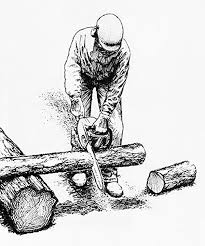
- Use the correct saw. The weight, power, and bar length should all be suitable for the job.
- Operate the chain saw in a firm two-handed grip with fingers and thumb surrounding the handles. Keep both feet firmly positioned when operating a chain saw.
- Maintain full power throughout each cut.
- Ensure that the chain does not move when the chain saw is idling.
- Turn off the chain saw before refuelling or doing any maintenance.
- Keep your saw clean — free of sawdust, dirt and oil.
- Wear safety gloves or mitts when sharpening the chain.
DO NOT
- Do not start a chain saw when it is resting against any part of your body.
- Do not refuel a chain saw within 3 m (10 ft) of a fuel storage container.
- Do not stand directly behind the saw.
- Do not leave a saw running unattended.
- Do not carry chain saws while it is running.
- Avoid contact with the muffler. Serious skin burns may result.
- Do not cut alone.
Click here to down the chain saw safety manual
